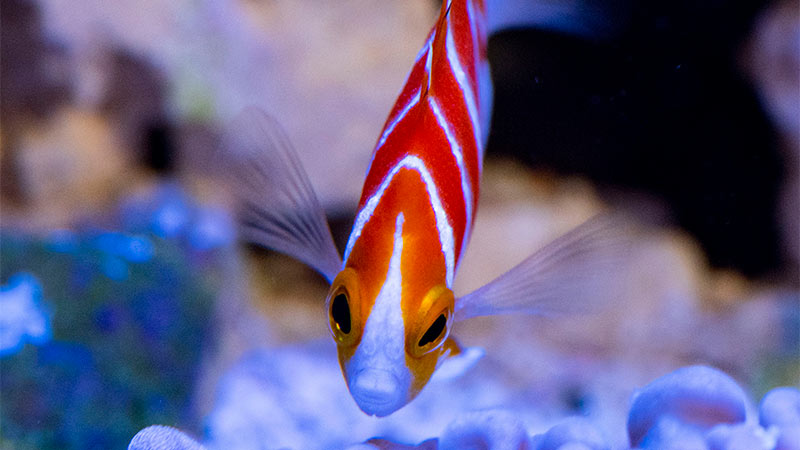Peppermint AngelfishThe Holy GrailOften referred to as “The Holy Grail” of marine angelfish by hobbyists and enthusiasts, the Peppermint Angelfish (Paracentropyge boylei), has been found in the deep waters of the Cook Islands. For those new to the quest for this elusive Pomacanthid, you need to understand its significance in the hobby and why this denizen of the South Pacific commands such a high price.BackgroundThe Peppermint Angel is a more recent discovery, as the species name indicates, it was discovered by Charles (Chip) Boyle. Most often found at depths of 300 to 400 feet, it takes a specially trained diver with rebreather equipment just to descend to such depths to avoid succumbing to the bends, known as DCS (decompression sickness). Once divers do reach the required depth, their time is limited, and they have the ensuing challenge of trying to capture and collect this cryptic angel in deep waters that only limited light reaches. Not to mention, Peppermint Angels are not swimming out and about in the water column, they reside in rocky caves and coral structures, so their accessibility is extremely limited. Once a Peppermint Angel is collected it must be handled with the utmost care and attention to ensure it is properly decompressed as it transitions from the depths to the surface. 

Conditioning and AcclimationLiveAquaria was fortunate enough to acquire one of only a small handful of Peppermint Angels ever available to the marine aquarium trade in the US. This little gem of a fish is approximately 1-1/2” in length and will only grow another inch or so with a max length of less than 3”. Under the watchful eye of Kevin Kohen, the visually striking angel has thrived. Kevin’s knowledge, research and 30+ years of experience went into the conditioning and acclimation of this magnificent fish. To simulate the angel’s natural environment, a chiller was installed on the 130 gallon aquarium that the Peppermint Angel resides in since deeper water means cooler temperatures. The aquarium temperature was initially set at 72.5 F°. Over the course of 7 weeks, the temperature has very gradually been increased to 74.5F°. In addition to proper temperatures, the lighting was subdued and reduced to 3% intensity. The lighting has also been gradually increased over the 7-week timeframe. Special attention was given to the aquascaping with stackable coral rock which provides caves, nooks and crannies to replicate the fish’s natural habitat, and ensure the Peppermint Angel feels at home, providing adequate security and shelter. Tank mates were carefully chosen for this unique angelfish, as the Peppermint Angel’s tank mates include a harem of Cook Islands Ventralis Anthias (Pseudanthias ventralis), which are familiar to the angel since they were also harvested from the same expedition in deep waters of the Cook Islands. Feeding and DietAs any marine aquarist knows, the biggest (and most nerve-racking) challenge to newly acquired fish is converting the fish to feed and accept food that is not accustomed to foraging on. Most often it is trial and error when feeding new arrivals. New fish arrivals often pick and nip at the food offerings and usually spit it back out. Prepared foods are foreign to the fish’s palate, so offerings must be varied in both type of food and particle size until something triggers a positive feeding response. Kevin and his dedicated team at LiveAquaria spent hours patiently watching and waiting to see exactly what types of foods the elusive Peppermint Angel would feed upon. Feeding efforts included staying after hours and coming in on the weekends to ensure our Peppermint Angel was keeping food down and receiving enough sustenance to thrive. It was all hands on deck with Kevin at the helm navigating the uncharted waters of Peppermint Angel husbandry. Fortunately, the angel was curiously nipping at the antennae of Trochus snails from day one, and very quickly the angel’s feeding response kicked in, taking a liking to specific foods and particle sizes. So what did it take to engage the Peppermint Angel’s feeding response? In preparation of the angel’s arrival the aquarium was loaded with multiple types of live Copepods. Once the Peppermint Angel arrived it was then offered live Artemia nauplii (Brine Shrimp) and a slurry of prepared frozen/thawed foods including enriched brine shrimp, minced mysis shrimp, Calanus, a blend of small fish eggs and even a few polyped corals to graze on if desired. Interestingly, the Peppermint Angelfish showed no interest in sessile Large Polyp Stony Corals or Zoanthus spp. Over time, the slurry of mixed foods has been refined to the Angel’s liking and is fortified with VitaChem® enrichment supplements. 
Doing Our PartThere is much to be learned about the habits and husbandry of Peppermint Angels. All of us at LiveAquaria are excited to share whatever we can glean from our temporary resident before this amazing angel is offered for sale in the Diver’s Den® WYSIWYG Store on LiveAquaria®. This is an angel for the aficionado or expert who will truly appreciate its provenance, potential and rarity in the aquarium trade. Our hopes are that the Peppermint Angel will eventually be paired up with another Peppermint Angel for breeding purposes which align with LiveAquaria’s mantra of offering sustainably raised aquatic life that is either aquacultured or responsibly harvested. |


